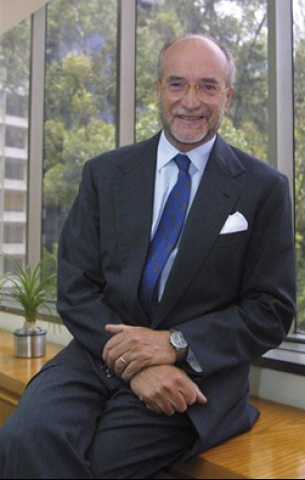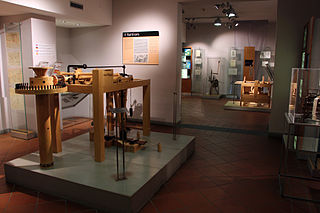
Museo Galileo is located in Florence, Italy, in Piazza dei Giudici, along the River Arno and close to the Uffizi Gallery. The museum, dedicated to astronomer and scientist Galileo Galilei, is housed in Palazzo Castellani, an 11th-century building which was then known as the Castello d'Altafronte.

SS Conte Biancamano was an Italian ocean liner launched in 1925. The name was chosen in honor of Humbert I Biancamano, founder of the Savoy dynasty. She was built in the Scottish shipyard William Beardmore & Co. in Dalmuir, near Glasgow. She was built for the Genovese shipping company Lloyd Sabaudo, operator of Conte Rosso and Conte Verde. The engine, equipped with two steam turbines double reduction unit and two propellers, allowed her to reach a speed of 20 knots, and vented in two funnels. She housed 180 passengers in first class, 220 in second class, 390 in economic class and 2,660 in third class.

The Codex Atlanticus is a 12-volume, bound set of drawings and writings by Leonardo da Vinci, the largest single set. Its name indicates the large paper used to preserve original Leonardo notebook pages, which was used for atlases. It comprises 1,119 leaves dating from 1478 to 1519, the contents covering a great variety of subjects, from flight to weaponry to musical instruments and from mathematics to botany. This codex was gathered in the late 16th century by the sculptor Pompeo Leoni, who dismembered some of Leonardo's notebooks in its formation. It is now in the Biblioteca Ambrosiana in Milan.

The FS Class E.550 was a class of three-phase electric locomotive used in Italy, introduced in the 20th century, which remained in service until 1965.

Patrick Mimran is a contemporary French multimedia artist, composer, and the former CEO of Lamborghini. He is most widely known for Lamborghini's turn-around in the early 1980s and his art exhibit, "The Billboard Project".
Science and Technology Museum may refer to:

Gianfelice Mario Rocca is an Italian billionaire businessman. He is chairman of the Techint Group and Istituto Clinico Humanitas.

Paul Biddle is an English fine art photographer, who specialises in creating carefully studied surreal artworks using real objects and studio lighting for artistic effects. He has exhibited widely both in Britain and around the world. He has won at least 15 international photography prizes.

The Icaro Stratos is an Italian high-wing, single-place, rigid-wing hang glider that was designed by Icaro 2000 in conjunction with A-I-R GmbH and Felix Ruhle and produced by Icaro 2000, of Sangiano, circa 2003.

Giuseppe Mazza was an Italian painter active in a Romantic style.

The Museo Ideale Leonardo da Vinci is located in Vinci, Leonardo da Vinci's birthplace, in the province of Florence, Italy. It is part of the Museo leonardiano di Vinci.
Paolo Galluzzi is an Italian historian of science.

Italian submarine Enrico Toti was the first of a new class of Italian submarine, with Enrico Toti being laid down in 1965, launched in 1967, decommissioned in 1992 and preserved as a museum ship at thea Museo della Scienza e della Tecnologia "Leonardo da Vinci", in Milan. The ship, and class, are named after the Italian war hero Enrico Toti.

The thermal power station Regina Margherita was a large power station for the production of electricity, preserved at the Museo nazionale della scienza e della tecnologia Leonardo da Vinci in Milan, Italy. The station opened in 1895 and was originally installed in the Egidio e Pio Gavazzi silk factory in Desio (Milan), where it operated until 1954. It supplied electricity for lighting and for the operation of 1,800 looms, generating alternating electric current at a voltage of 200 V.

Ebe is a former training ship of the Italian Navy. Initially a merchant vessel named San Giorgio, she was acquired by the Navy and used to train non-commissioned officers between 1952 and 1958. Since 1963 she has been preserved and exhibited at the Museo Nazionale Scienza e Tecnologia Leonardo da Vinci in Milan.

Leonardo3 is an interactive museum and exhibition center at Galleria Vittorio Emanuele II, Piazza della Scala, Milano, Italy. The museum was inaugurated in 2013, and is devoted to Italy’s notable personality Leonardo da Vinci, who is portrayed both as an artist and inventor.

The Museo Leonardiano di Vinci, or Leonardian Museum of Vinci, is a museum dedicated to Leonardo da Vinci, located in Vinci, Leonardo's birthplace, in the province of Florence, Italy.

The Italian polymath Leonardo da Vinci drew his design for an "aerial screw" in the late 1480s, while he was employed as a military engineer by Ludovico Sforza, Duke of Milan from 1494 to 1499. The original drawing is part of a manuscript dated to 1487 to 1490 and appears on folio 83-verso of Paris Manuscript B, part of the papers removed from the Biblioteca Ambrosiana in 1795 by Napoleon and still held by the Institut de France in Paris.

































